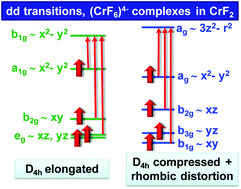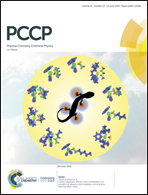Explaining the optical spectrum of CrF2 and CuF2 model materials: role of the tetragonal to monoclinic instability
Abstract
The properties of MF2 (M = Cr, Cu) model compounds are usually interpreted assuming a Jahn–Teller effect leading to elongated MF64− units. By means of the analysis of experimental data and first-principles calculations on both the monoclinic P21/c structure and the parent rutile structure (tetragonal P42/mnm space group), we prove that such an assumption is not correct. It is shown that in MF2 compounds, the MF64− complexes are actually compressed in the parent phase but along a different direction, a situation that is however hidden by an additional orthorhombic instability due to a negative force constant of b2g and b3g modes of the cell. This distortion plays a key role in understanding the high experimental value of the lowest d–d transition energy, E1 = 1.23 and 0.93 eV for CrF2 and CuF2, respectively, when compared to the value E1 = 0.40 eV derived for the Jahn–Teller system of KZnF3:Cu2+. Aside from reproducing reasonably the experimental values of spin allowed d–d transitions of both compounds, our first-principles calculations show the existence of an accidental degeneracy involving the yz and xy levels in the final P21/c structure. Moreover, the internal electric field of CrF2 and CuF2 is found to be much less anisotropic than in layered compounds like K2CuF4 and thus it has little influence on the d–d transition energy. The influence of the (3z2 − r2) − (x2 − y2) hybridization, caused by the orthorhombic distortion, on the electronic density and the magnetic coupling between layers is also briefly discussed. The present results stress that the interpretation of experimental data using simple parameterized models can lead to wrong conclusions.

- This article is part of the themed collection: 2019 PCCP HOT Articles


 Please wait while we load your content...
Please wait while we load your content...